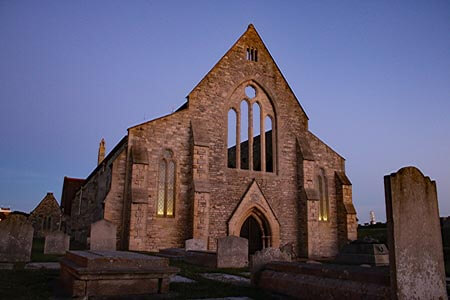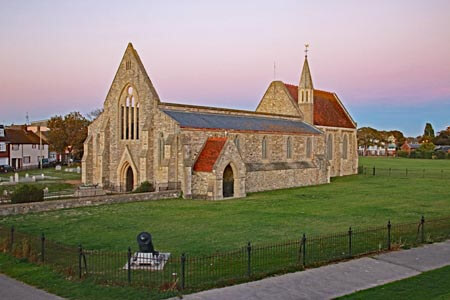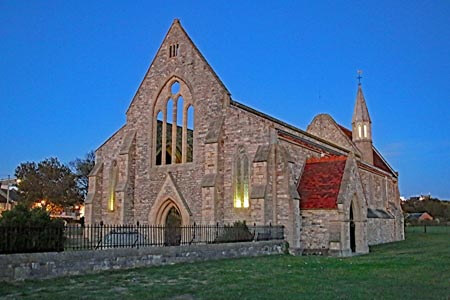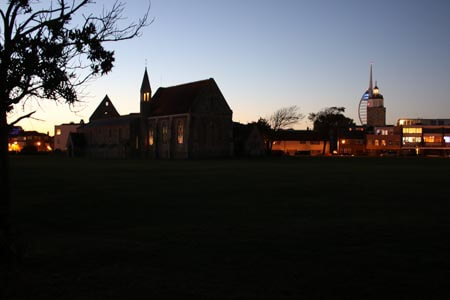Royal Garrison Church Portsmouth

The Royal Garrison Church is a historic building in Penny Street, Old Portsmouth, is also known as the Domus Dei' or gods house.
The building started life as a hospital for overseas pilgrims travelling to the holy shrines at Canterbury, Chichester and Winchester, it was once known as the Cathedral Church of the British Army.
Founded in 1212 by Peter de Rupibus, the Bishop of Winchester, the Domus Dei was founded as a hospital or shelter for pilgrims who landed in Portsmouth en route to the holy shrines of Canterbury, Chichester and Winchester.
The building was originally laid out as a long vaulted hall with bays on either side to house patients.
There was a master or warden in charge and six brethren and six sisters to look after and tend to the needs of the sick.
In 1450 the Bishop of Chichester, Adam Moleyns, was murdered outside of the church, whilst on the business of Henry VI. The bishop had been sent to the church, with instructions to pay the soldiers and sailors based at the garrison. There was disagreement as to the correct amount that should be paid and the Bishop was murdered during the disturbance that followed.
As punishment for this the town of Portsmouth was excommunicated by the Catholic Church, meaning that no religious services could take place in the town, this lasted for 50 years until the citizens built a new chapel as reparation.

During the dissolution, in the reign of Henry VIII, the church was closed. John Incent, the master at the time, 1540, surrendered the church and as a reward he was made Dean of St Paul's, London. In this period it is believed the buildings were used as an armory.
In 1658 the former residential part of the Domus Dei was converted into a residence for the Governor of Portsmouth, the Governor moving here from the Square Tower just around the corner in Broad Street. The new residence was known as Government House and it was here in 1662 that King Charles II married Catherine of Bragnanza on the 21st May. Catherine was a daughter of John IV of Portugal and is widely recognised to have introduced the drinking of tea into Britain, a practice already popular with Portuguese nobility.
The final official use of Government House was in 1814 when the Allied Sovereigns were entertained there. This party included the Prince Regent, the Emperor of Russia, the Duke of Wellington and Marshal Bulcher and was held to celebrate the signing of the Treaty of Paris. The building was demolished in 1826.
The church continued to be used for services by the garrison troops, but it was falling into a state of disrepair. In 1861 GE Street the Victorian architect, wrote a report outlining the state of the building and money for a major restoration was raised by a combination of army and navy funds plus some public donations. The restoration started in 1866 and was completed in 1868.
During the second world war many parts of Portsmouth were damaged by German air raids during the Blitz. During a famously severe raid on January 10th 1941, the nave of the church was hit by incendiary devices and gutted by the ensuing fire. The chancel was saved by the efforts of the Verger J. Heaton aided by soldiers and airmen who were stationed nearby. As a memorial to the blitz, the main roof section of the building was never repaired and so the main part of the building remains roofless still.
The chancel at the western end of the building is roofed however and as well as acting as a church, also houses many interesting artifacts, photographs, regimental colours and other items such as the wooden carved Victorian font cover, look out for the secret door leading to the bell tower. On the northern side of the chancel is an impressive church organ, hidden in a side chamber of the building. A small number of services are held in the chancel, mainly by ex-service associations.
Royal Garrison Church details:
The church is open to the public from April to September, from 11am to 4pm and is staffed by very knowledgeable volunteers who are more than happy to show you around and share the history of the building with visitors.
Admission is free, but donations are of course very welcome.
Address: Royal Garrison Church, Penny Street, Old Portsmouth, PO1 2NJ
The 'Domus Dei' at Old Portsmouth

